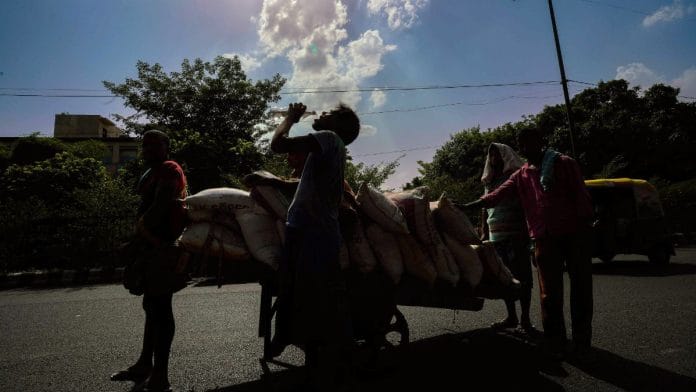New Delhi: At least 84 percent of the districts in India are prone to extreme heatwaves, with most parts of the country recording the deadly combination of high heat and intense humidity levels even during monsoon months, a new study has highlighted.
According to the report ‘Managing Monsoons in a Warming Climate’, released by IPE Global and Esri India, in partnership with the United Nations Educational, Scientific and Cultural Organization (UNESCO) Tuesday, 70 percent of the heat-prone districts are also witnessing increased frequency and intensity of extreme rainfall events.
Gujarat, Rajasthan, Uttarakhand, Himachal Pradesh, Maharashtra, Uttar Pradesh, Meghalaya and Manipur are some of the hotspots that have been experiencing extreme heatwaves and rainfall over the last few decades.
“The frequency, intensity, and unpredictability of these extreme heat and rainfall events have also risen in recent decades,” the report read.
The researchers also found that there was a 15-fold increase in extreme heatwave days in India across the summer months (March-April-May) and the monsoon months (June-July-August-September) over the past three decades.
In the winter months — October, November and December — more than 62 percent of the heatwave-prone Indian districts witnessed erratic and constant rain, highlighting how increased atmospheric temperatures and humidity increase the likelihood of heatwaves globally, especially in tropical regions.
The last decade alone recorded a 19-fold increase in extreme heatwave days. The study also found that the monsoon in India is witnessing extended summer-like conditions, except on rainy days.
“The current trend of catastrophic extreme heat and rainfall events result from 0.6 degrees Celsius temperature rise in the last century. El Niño is gaining momentum and making its early presence felt globally,” said Abinash Mohanty, head of climate change and sustainability practice at IPE Global, and the author of the study.
He said that the analysis also forecasted that eight out of 10 Indians are likely to be highly exposed to extreme climate events by 2036.
“These numbers speak volumes. Embracing hyper-granular risk assessments and establishing climate-risk observatories should become a national imperative to safeguard Indian agriculture, industry and large-scale infrastructural projects from the vagaries of climate change,” he added.
Ashwajit Singh, IPE Global’s founder and managing director, said that there is a 59 percent chance that 2024 will be ranked as the warmest year on record and a 100 percent chance that it will at least be among the top five warmest years in history.
He said that climate change will multiply the existing developmental challenges, and if timely mitigation and adaptation measures are not implemented, millions of people will be dragged into poverty, especially in developing countries.
The study is the first of its kind to evaluate heat risks at district level and study extreme rainfall trends, while correlating the two. Researchers have also developed a region-specific temperature thresholds roster on a multi-decadal time scale (1993–2022) to give a clearer picture of temperature and rainfall aberrations in each decade.
Apart from highlighting extreme heat and rainfall trends in Indian districts, the land sensitivity assessment conducted for the report also highlighted that around 55 percent of land use and land cover change in India was concentrated in “hotspot districts”, which are experiencing the worst impacts of climate change.
According to researchers, anthropocentric activities contributed to this large-scale change in climatic patterns.
(Edited by Mannat Chugh)






